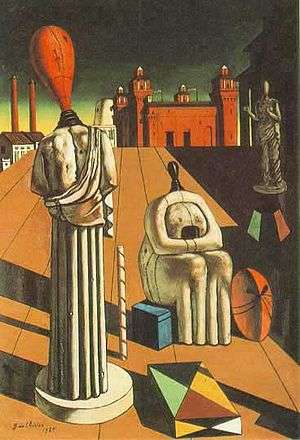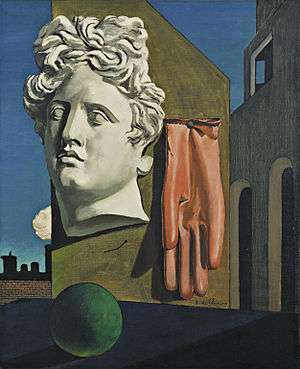Metaphysical art

Metaphysical art (Italian: Pittura metafisica) was a style of painting that flourished mainly between 1911 and 1920 in the works of the Italian artists Giorgio de Chirico and Carlo Carrà. The movement began with de Chirico, whose dreamlike works with sharp contrasts of light and shadow often had a vaguely threatening, mysterious quality, 'painting that which cannot be seen'.[1] De Chirico, his younger brother Alberto Savinio, and Carrà formally established the school and its principles in 1917.
Development


While Futurism staunchly rejected the past, other modern movements identified a nostalgia for the now faded Classical grandeur of Italy as a major influence in their art. Giorgio De Chirico first developed the style that he later called Metaphysical Painting while in Milan. It was in the more sedate surroundings of Florence, however, that he subsequently developed his emphasis on strange, eerie spaces, based upon the Italian piazza. Many of De Chirico's works from his Florence period evoke a sense of dislocation between past and present, between the individual subject and the space he or she inhabits. These works soon drew the attention of other artists such as Carlo Carrà and Giorgio Morandi.
In his painting Turin Melancholy (1915), for example, he illustrated just such a square, using unnaturally sharp contrasts of light and shadow that lend an aura of poignant but vaguely threatening mystery to the scene. The arcades in this painting, as well as the deep perspectival space and dark-toned sky, are pictorial devices typical of De Chirico’s strange, evocative works. He gave his paintings enigmatic titles—such as The Nostalgia of the Infinite (1913–14), The Philosopher’s Conquest (1914), and The Soothsayer’s Recompense (1913)—that contribute to their cryptic effect. Other Metaphysical painters included Filippo de Pisis and Mario Sironi.
In 1917, in the midst of World War I, Carrà and De Chirico spent some time in Ferrara, where they further developed the Metaphysical Painting style that was later to attract the attention of the French Surrealists.
The Metaphysical school proved short-lived; it came to an end about 1920 because of dissension between De Chirico and Carrà over who had founded the group.
References
- ↑ Conway Morris, Roderick, De Chirico: "Painting Landscapes of the Mind, International Herald Tribune, Feb 11 2007
Sources
- Onians, John. Atlas of world art. Laurence King Publishing, 2004. p. 288. Web. 07 Oct. 2011.
- "Metaphysical painting". Encyclopædia Britannica. 2011. Web. 07 Oct. 2011.